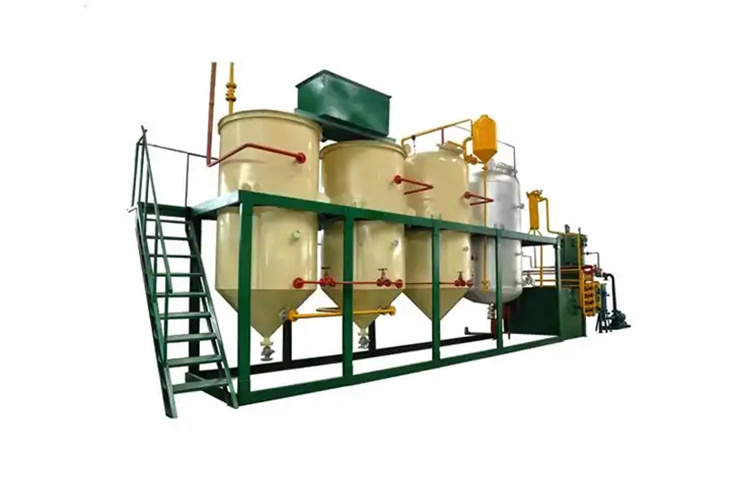Soybean oil is one of the world’s top five edible oils and one of the edible oils we see most in our daily life. Soybean oil is commonly processed by two processes: pressing in oil presses and leaching in oil solvent extraction equipment. The soybean oil extracted from these two processes is called crude oil or gross oil in edible oil standards.
Setting up a soybean oil refinery plant is an ambitious but rewarding venture now. With the increasing demand for high-quality soybean oil, understanding the intricacies of the refining process and the necessary refining machines can significantly boost efficiency and profitability. This blog will walk you through the essential soybean oil refinery process steps, machines, and considerations for starting your own soybean oil refinery business.

About the batch type Soybean oil refinery plant, it included four mainly sections:degumming, deacidification, decolorization, deodorization.

Degumming
Crude oil often contains phospholipids, also known as gums. These gums can cause problems during storage and frying, such as foaming and darkening of the oil. In the degumming process, a small amount of water or an acid – based degumming agent is added to the crude oil. The phospholipids hydrate and form a sludge that can be separated from the oil through centrifugation.
Deacidification
Free fatty acids in crude oil can cause unpleasant taste and odor. In the deacidification step, a certain concentration of NaOH (sodium hydroxide) is added to perform an acid-base neutralization reaction to remove free fatty acids from the oil.
Decolorization
After neutralization, there may still be some color impurities in the oil. Decolorization is performed by treating the oil with a decolorizer (usually activated clay). 1-3% of the weight of the oil is added to the decolorizer for physical adsorption, and then a filtration device is used to separate the oil from the decolorizer to achieve the decolorization purpose.The decolorizer absorbs the impurities that cause the color, making the oil lighter and more attractive.
Deodorization
The last step in the refining process is deodorization. At high temperatures of 220-260°C and certain vacuum conditions, a certain amount of superheated steam is introduced to strip the oil, and the deodorization is achieved according to the different volatilization points of the oil and volatile small molecules. In this step, volatile compounds (including unpleasant odors and tastes) are removed, resulting in refined oil with a neutral taste and odor.
Features
1. It adopts food grade stainless steel material and is polished; it meets the national food machinery standard.
2. Simple design and exquisite appearance to improve customer satisfaction.
3. The operation data is all displayed by the meter, the operation is simple, and the operation is safe; the ordinary staff can work on the machine after watching the operating video.
4. It can realize the functions of dephosphorization, deacidification, decolorization, dehydration.
5.It is suitable for refining various crude oil, vegetable oil, such as sunflower seed oil, tea seed oil, peanut oil, soybean oil,corn oil, groundnut oil, palm kernel oil,rapeseed oil and so on.
How to Start Your Own Soybean Oil Refining Line with the Best Business Plan?
Whether your soybean oil refinery is large or small, a few common questions when building one of your own are as follows:
How well do you understand the demand of the soybean oil market?
Have you conducted adequate technical and technological research before investing in a soybean oil refining plant?
Have you made a detailed estimate of the investment cost of building a soybean oil refinery?
Have you developed an effective marketing strategy?
Have you obtained all the necessary licenses and approvals to build the plant?
The Soybean Oil Refinery Project Plan will provide investors with clear direction to help clients take a solid step forward in this field of opportunity. Through five key steps, we will explore an all-encompassing guide from market analysis to equipment procurement to production processes and marketing, enabling investors to gain a deeper understanding of how to successfully build their own soybean oil refinery.
